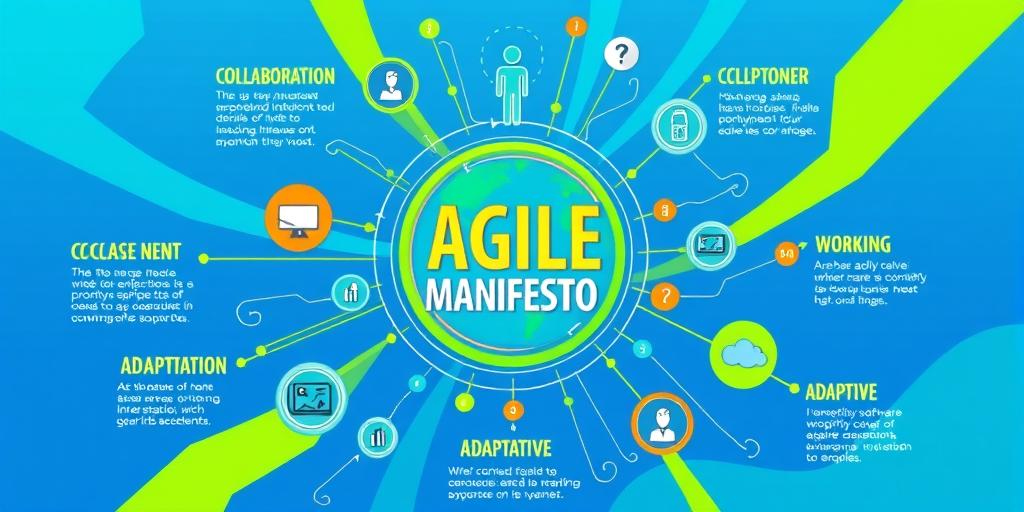How the Agile Manifesto Revolutionized Software Development
Did you know that software development used to be a rigid, waterfall-like process, often leading to projects that missed deadlines and failed to meet client expectations? But then, like a phoenix rising from the ashes, came the Agile Manifesto, revolutionizing how we build software! This groundbreaking document completely shifted the paradigm, paving the way for faster, more adaptable, and customer-centric software development. Let’s dive into how this revolutionary approach reshaped the tech world.
The Genesis of Agile: A Rebellion Against Traditional Methods
Before Agile, the traditional waterfall model dominated software development. Imagine a rigid, inflexible system, where progress flows in a linear fashion, from requirements gathering to design, implementation, testing, deployment, and maintenance. Problems? Well, they often emerged late in the process, causing expensive and time-consuming setbacks. Agile methodologies, on the other hand, embrace iterative development and a focus on flexibility.
The Waterfall Model’s Shortcomings
The waterfall model’s rigidity led to several key problems. One major issue was its inability to accommodate changing requirements. In today’s rapidly evolving market, client needs and project specifications change constantly. The waterfall method struggles to keep up, often resulting in a final product that misses the mark. Delays were also a huge problem. The sequential nature of the waterfall method means that a problem in one stage can significantly impact the entire project schedule.
Agile’s Iterative Approach: Embracing Change
Agile, unlike waterfall, is all about embracing change. It utilizes short development cycles known as sprints or iterations. Each sprint delivers a working piece of the software, allowing for continuous feedback and adjustments. This continuous improvement cycle means that project teams can adapt swiftly to changing requirements, ensuring they are always building the right thing, in the right way, at the right time.
Core Principles of the Agile Manifesto
The Agile Manifesto is built upon four key values and twelve supporting principles. These guide Agile teams toward collaborative, customer-centric, and adaptable software development. This core philosophy prioritizes individuals and interactions over processes and tools, working software over comprehensive documentation, customer collaboration over contract negotiation, and responding to change over following a plan.
Understanding the Agile Values
These four values form the bedrock of Agile development. The focus on individuals highlights the importance of a team’s collective expertise and communication. Prioritizing working software ensures that functional products are continuously delivered. Customer collaboration emphasizes constant feedback loops, and responding to change acknowledges the dynamic nature of software development projects. These values together create the perfect storm for successful software projects.
Embracing the Agile Principles
The twelve principles that underpin the Agile Manifesto reinforce these values. They emphasize teamwork, continuous improvement, frequent delivery, customer satisfaction, and responsiveness to change. Agile methodologies provide a framework for teams to implement these principles, allowing for a dynamic and successful development process. Understanding these principles is paramount to successfully implementing an agile methodology.
Popular Agile Methodologies: Scrum, Kanban, and More
Several Agile methodologies have emerged based on these principles, catering to various project needs and team structures. Scrum, Kanban, and Extreme Programming (XP) are among the most widely adopted. Each methodology offers a unique set of practices and tools, but all share the core Agile values and principles.
Scrum: The Iterative Framework
Scrum is a popular iterative and incremental framework that emphasizes teamwork, accountability, and iterative progress toward a well-defined goal. Teams often use scrum boards to visualize and manage the workflow. A scrum master guides the team, ensuring alignment with Agile principles and addressing any roadblocks.
Kanban: Visualizing Workflow
Kanban focuses on visualizing workflow and limiting work in progress (WIP). It uses a Kanban board to depict the stages of a project, allowing for improved task prioritization and better resource management. Its flexibility makes it particularly useful in dynamic environments.
Extreme Programming (XP): Emphasis on Quality
Extreme Programming (XP) prioritizes software quality through continuous testing, short development cycles, close collaboration, and simple designs. This methodology focuses heavily on technical excellence and customer satisfaction by providing them with early access to functional software.
The Enduring Legacy of the Agile Manifesto
The Agile Manifesto’s impact on software development is undeniable. It fostered a cultural shift, moving away from rigid, inflexible processes to collaborative, adaptable environments. By prioritizing customer satisfaction, responsiveness to change, and continuous improvement, Agile has enabled the creation of high-quality software that meets evolving market demands. The Agile methodologies are still evolving, responding to the dynamic nature of the software development landscape. They continue to be refined to meet the demands of projects both large and small. The manifesto’s principles remain essential to modern software development practices.
Ready to embrace the Agile revolution and build better software? Start your Agile journey today! Learn more about Agile certifications and training to enhance your software development skills!













